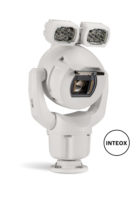ROG Security Cloud Service from ROG Security Inc. enhances a facility’s video system with real-time video threat analysis by using ROG’s cloud-based artificial intelligence and advanced neural network learning system.
In business since 2016, the idea for ROG came from the remote guarding industry, said COO Jordan Lippel. “That concept was fantastic, but we saw a gap between an alert reported to a command center and the action taken. Usually by then the crime is already done. We designed a low-cost system that actually sends alerts straight back to someone on the ground that can take swifter action.”
These alerts are based on a customer-driven set of rules that allow the camera to look for anomalies. For $12.75 per camera (dealer price), ROG can be installed on almost any camera available today, Lippel said.
“To install a new camera with analytics could be up to $3,000 and you have to have it set up and configured,” Lippel explained. “Ours empowers the end user to change analytics per day, per hour, or per shift and our price point is significantly less.”
For end users with a lot of installed cameras this can be a significant cost savings, he says. “If you look at a stadium that has 150 cameras, that is a big expense, verses using a ROG system for those they don’t have the capital to make analytics-based cameras.
“ROG is like Ring on steroids,” Lippel added. “You put this on your camera and it allows you to get alerts and take any action you want.”
For the security dealer or integrator, the ROG system allows them to turn almost any camera into a SaaS opportunity, Lippel explained. Several dealers have already signed on to use ROG to offer proactive threat detection on a monthly basis, particularly those that already have a command center.
“Most camera integrators install hardware and hope for an annual service or proactive maintenance contract for RMR,” Lippel said. “This is truly an RMR piece.” ROG is provided as a book of licenses that allows the dealer or end user to do whatever they want with, he explained. “They can put it on camera A one day and move it to camera B, C or F every day. It empowers the user to set up their own analytics. The big differentiator is once they are configured, if you want to change them you don’t have to go through a grueling process like you might with regular analytic cameras. We created a Microsoft Paint-like experience to make it easy to change or configure on the fly.”
The brains behind ROG is a cloud-based neural network that takes non-smart cameras and turns them into a machine-learning “smart” device. Rather than just look at motion, ROG employs true machine learning, explained Brad Feldman, CEO and co-founder of ROG. “Inspired by how the brain works, a neural network is really just a fancy way to create a computer system that ‘learns.’ A neural network learns by seeing lots of examples of something and then over time it makes predictions on new information. For example, with a neural network you can teach the computer what a baseball bat is by showing it lots of images of what is and what is not a baseball bat. Over time, the computer becomes more confident in accurately identifying a bat from a broom. This is object recognition.”
While some much older analog cameras might not be the best candidate, Lippel added that they have yet to find a camera ROG doesn’t work on. “We take any camera, put a software or license on it and make it in laymen’s terms, ‘smart.’
“We are taking machine learning and retrofitting it on existing cameras,” Lippel said. “With ROG you are looking for behavioral trends and helping clients have safer environments.”






